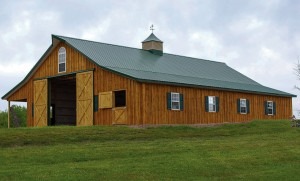Are Your Horse Barns and Sheds Winterized? Do a midwinter check.
 Winter means cold days in the horse barn and often battling the elements to keep your horses watered and fed. Fortunately, the cold weather bothers us a lot more than our equine friends. Still, as a leading horse barn builder, we know that maintaining proper shelter is essential whether your horses are spending most of their time indoors or out. Now is a good time to do a midwinter check and make sure your horses are adequately protected.
Winter means cold days in the horse barn and often battling the elements to keep your horses watered and fed. Fortunately, the cold weather bothers us a lot more than our equine friends. Still, as a leading horse barn builder, we know that maintaining proper shelter is essential whether your horses are spending most of their time indoors or out. Now is a good time to do a midwinter check and make sure your horses are adequately protected.
The Barn
On a clear day, check your gutters and spouts and remove any obstacles or debris. Inspect the roof for any damage or leaks from extreme weather. Then inspect again in wet weather to ensure that water is shedding away from the barn.
Monitor the interior of your barn for signs of dampness or water condensation, which can ruin your structure and harm your horses’ health. If you find any condensation, address it by increasing ventilation to that area and cutting off sources of humidity. Barn air, like attic air, should be cool and dry in the winter.
Air Quality
Do an ammonia check every time you enter the barn. If you can smell ammonia, the levels are too high, posing the risk of respiratory ailments. You can remedy this by changing bedding more frequently, preferably when your horses are outside to minimize dust inhalation. You can also address ammonia buildup by opening windows, doors and vents. Your barn should have outdoor air flowing through it at all times, no matter how cold it gets.
Physical Hazards
Inspect doorways, stall doors and walls to remove any protruding nails or other physical hazards that could cut a horse or entrap a leg. You should also check that your electrical lines are intact and working properly. Monitor use of electrical cords closely to ensure proper handling and storage.
Your Water Source
Check your watering system to ensure that it is providing consistent access to unfrozen water. Studies have shown that horses will drink more water when it is warmed, but they prefer cold water when given a choice. While the ideal temperature may be up for grabs, you need some way to ensure that their water source is consistently available, particularly within three hours after feeding when they drink the most.
The Shed
If your horses are pasturing this winter, they’ll need a solid run-in shed for shelter. The shelter should be oriented with the open end facing south to admit the sun and the front aligned to block prevailing winds.
Inspect your shed periodically to ensure that no protrusions or holes have developed that could cause cuts or entrapments. All exposed metal elements that are within kicking level should be reinforced with plywood to prevent horses from kicking through. Also check to ensure that the ground beneath the shed is staying dry and level at all times.
It also pays to observe how your horses are using your shed. Make sure that dominant horses are not preventing submissive ones from entering. If that happens, you may need to provide a second shed.
Short Days, Big Chores
A midwinter check of your structures will ensure that your horses come through the winter healthy and sound.
If you’re in the market for a new barn or shed, contact us today to learn more.
